- You are here:
- FAOL Home >>
- Articles >>
- Reviews >>
- Product Reviews

All our preparation, consideration and decisions regarding our gear come to the test at the moment we begin our first cast. The gear has to perform at the level we demand ... as we expect it to ... as we know it will. That's what this section is all about. Performance and expectation! The products ... rods, reels, lines and the rest of the angler's arsenal ... featured in these articles are evaluated by our staff of anglers. These anglers come from every level of the sport ... novice to expert. Each has a different perspective, and experience level from which they view and evaluate "quality and performance" in the products reviewed. This is good ... it provides you with definite information from the eyes of real anglers fishing their streams, increasing their knowledge and taking this opportunity to share it with you.
FLUFF AND FEATHERS
My fascination with fluff and feathers started long ago, in a far away place, or so seem now. I started fly tying at a young age and once I discover that feathers were used to tie flies no bird was safe. My Uncle, who is a Federal Bird Bander, had to counsel me that releasing a Cardinal or Blue Jay after banding didn’t mean that you removed any feathers. He had to explain that House Sparrows, Starlings or legally taken game birds were the only ones which I could pluck, except for barnyard birds, like ducks, geese and chickens.
To molest such birds was to incur the wrath of my Grandmother and even at a young age I knew better than that! I did learn that some of the fly tying supply houses sold all sorts of feathers and bird skins. I must confess that the Herter’s Catalog was one of my favorites. My first dry fly neck was an India Neck. Some of you will know what I am talking about while others may wonder what I am talking about. Regardless, I doubt that many of today’s fly tiers would be willing to tie dry flies with those India Dry Fly Necks. Today we have Whiting’s, Spenser, Metz’s and a host of others.
Several months ago I received some hackle which was sent to me at the request of the Ladyfisher. The hackle selection came from Dennis and Liz Conrad, a father and daughter team that own and operates Conranch Hackle. I was so impressed with the quality of the hackle that I received I soon sent off a check for more of their product!
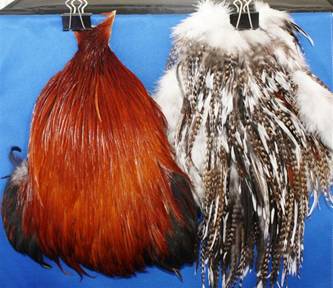
Conranch Hackle is one of the sponsors of FAOL, however, I would not write glowing review unless I was impressed with the product. I write these articles to share the knowledge.
The first thing I did after receiving the hackle from Conranch was to check out the web-site. For you to do so all have to do is click on the word sponsor on the title page of FAOL or go to www.conranch.com
Now I can hear the groaning already, what more advertising! Yes, without advertising and paying sponsors FAOL would not be available to you. Furthermore, you will find that there is advertising and then there is information which will help you better understand the products you are using.
I downloaded and printed 26 pages from their web-site, which I found very educational. The product is well display and explained on the site. Furthermore there two articles, one by Elizabeth “Liz” Conard and one by Dennis Conard. Both articles are well done, and very informative.
My next step was to call Dennis and I spent an hour on the phone talking hackle, both wet and dry, fly tying, fly fishing, rod building and fly fishing literature. It was very evident to this writer that Conranch Hackle is just not a business for Dennis, but a way of life. It was a real pleasure for me to have this time to visit with Dennis and I am sure that we will talk again. The flock of birds at Conranch Hackle can be dated to one of the most famous flocks in American Fly Fishing History. Now, I’ll bet you are wondering, “What Flock?” Ask Dennis.
For me, the quality of the wet hen hackle is just as important as the quality of the dry fly hackle. I could ramble on about the stems, the barb count and so on, but I won’t. However, I will state that this is some of the finest hackle I have ever used. The way the hackle wraps (Both wet and dry hackle) is a fly tier’s dream. Also, they have some of the best retail pricing I have ever found for high quality hackle. The reason is that you will not find Conranch Hackle Products in Fly Shops. They sell their products straight to the user. By cutting out the middle man they have kept the prices reasonable. By the way, do you know how hard it is to find good Cree Dry Fly Necks, if not call Dennis and you will get an education. Now, I will share some photos with you and some of the patterns I have tied using the Conranch Hackle:
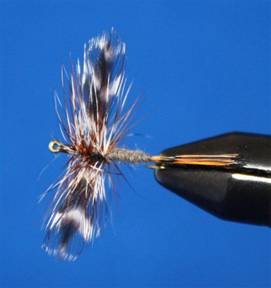
1. Spent Adams, Male
- Hook: TMC 101 Sizes: 10-22
- Thread: 12/0 Dark Dun
- Tails: Golden Pheasant Crest Tippets
- Body: Dubbed, Muskrat Fur
- Wings: Two Hen Grizzly Hackle Tips, Tied spent
- Hackle: One Grizzly & One Brown, dry fly hackle, wrapped, mixed
Notes: I also tie the Spent Adams, Female, and the pattern is the same except I dubbed a little yellow egg at the base of the tails before dubbing the muskrat fur body. On rivers like the Yellowstone, Madison and Big Hole the Spent Adams is still a highly effective pattern. Also, the way it rides on the surface makes it easier for the anglers to see the imitation on the water. This pattern lost its place in the Fly Shop bins years ago; however the trout seem to like it just fine. During the Mayfly season I often use various sizes of Spent Adams as a searching pattern, with excellent results. I have also used this pattern on Soda Butte Creek, the Lamar River and Slough Creek in the park where the water is flat and smooth. Using this same basic style I tie several different color spinners, using various colored Biots for the bodies and hackle fibers for the tails.
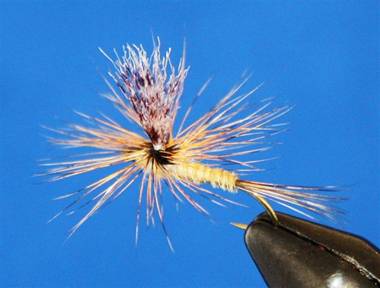
2. Paradun Callibaetis Cree
- Hook: TMC 101 Sizes: 16-20
- Thread: 12/0 Lite Dun
- Tails: Cree dry fly hackle fibers
- Abdomen: Callibaetis Turkey Wing Quill Fibers or Biot wrapped
- Wingpost: Medium Dun Saap Wing Fiber, mottled with a Brown Sharpie marker
- Thorax: Lite Dun Grey, Beaver fur dubbing
- Hackle: Cree dry fly hackle, tied parachute style
Notes: I have been using the mottled Cree hackle for years. Long ago, I discovered that many of the insects that we imitate are not one solid color; rather they are a variety of colors. The Cree hackle represents this so well. Years ago, one of my suppliers came into my fly shop, in the course of showing me various products; he set out three or four reasonably nice Cree Dry Fly Necks. I inquired about the price of the necks and he told me he seldom sold them and if I was interested he would make me a deal. Well, I end up with all of them! He couldn’t sell them because he had no idea what and why they were used! I might also note that when tied in sizes 12 & 14’s, this pattern works pretty well as a Gray Drake Imitation.

3. Callibaetis/Gray Drake Spinner
- Hook: TMC 101 Callibaetis Sizes: 16-20
- Thread: 12/ Dark Dun
- Gray Drake Sizes: 12-14
- Tails: Cree dry fly hackle fibers, tied long
- Abdomen: Muskrat Gray Turkey Wing Quill Fibers or Biots wrapped
- Wings: Oversized Cree dry fly hackle wrapped tightly together in the wings area, then divided the fibers into two bundles, in the spent position and post the base of the wings with thread. This will keep them from collapsing,
- Thorax: Lite Dun Beaver fur or Muskrat fur dubbing.
Notes: This type of spinner wing requires a little practice, however, in my opinion it is the finest and most effective spinner wing around. This wing style was developed by Vincent C. Marinaro back in the late 1940’s. It has never been popular as it is much more time consuming than laying a piece of antron in the wing position and lashing it down!
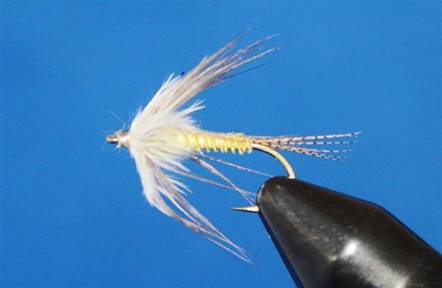
4. PMD Flymph
- Hook: TMC 101 Sizes: 16-20
- Thread: Sandy Dun 12/0
- Tails: Wood-Duck Flank Fibers
- Abdomen: Turkey Wing Quill Fibers or Biots dyed PMD, wrapped
- Thorax: Dubbed, Beaver Fur dyed PMD
- 1st Hackle: Lite Dun Hen Hackle, wrapped 1 ½ to 2 turns,
- 2nd Hackle: Natural Lite Dun, after-shaft feather, again 1 ½ to 2 turns
Notes: The Flymph was designed by James Leisenring during the 1930’s and I believe due to their designed sparseness and the method Leisenring developed to fish these imitations that they were emerging nymphs. Once again, this is a pattern style that only enjoys a moderate following among anglers. However, I have found this pattern style to wildly popular with the trout. My flymphs are somewhat modified from those tied by Leisenring. The second hackle on the pattern is something I added years ago after a conversation with the late Jack Gartside. The Turkey Wing Quill Fibers or Biot is my own modification, though I doubt that I was the first to do so.

5. Olive Soft Hackle
- Hook: TMC 100 Size: 10-22
- Thread: Olive Dun 8/0
- Body: Turkey Wing Quill Fibers or Biot dyed Lite Olive, wrapped
- Thorax: Dubbed, Hareline Rabbit, Olive Dun
- Hackle: 1 ½ to 2 turns of Lite Dun Hen Hackle
Notes: Many standard soft hackle or spider imitations are tied with wild game bird feathers. However, when you have the proper wet hen hackle these patterns can be constructed with this hackle and are just as effective as those tied with game bird hackle. I use lots of soft hackle and spiders; however, it is much easier to find small hen hackle than it is small game bird feathers for sizes 18 to 22. The hen hackle from Conranch Hackle is some of the best I have used for this purpose.
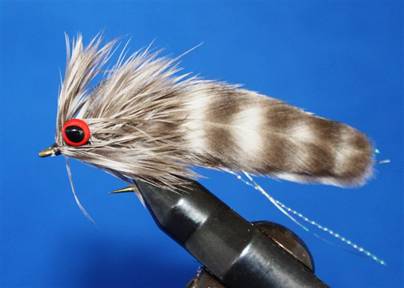
6. Mottled Dun Baitfish Minnow
- Hook: TMC 105 Size: 6-10
- Thread: Dark Dun 12/0
- Wing/Body: Four matched Mottled Dun Hen Hackles, Two strands of Pearl Krystal Flash and two strands of Silver Motion Mylar tinsel, the flash and tinsel are tied on first, and then the feathers are set into position, two on either side with the dull side of the feathers facing in.
- Collar: Mottled Dun Hen Hackles, 3 to 6 Feathers will be needed, match them up two each and tie them in by the tips and wrap and comb while moving forward
- Eyes: Red with Black Centers, either 3D applied with epoxy or Dumb-bell style eyes.
Notes: The hook is a wide gape, egg fly hook which I use for many different imitations. This little minnow will work on Trout, Bass and Bluegills. This is a quick little imitation to construct and highly effective. But the secret to the pattern’s success is the nicely shaped hen hackle.
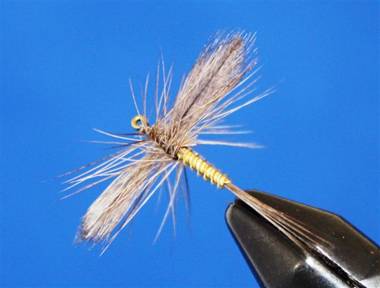
7. Olive Dun Spinner
- Hook: TMC 101 Sizes 10-22
- Thread: 12/0 Dark Dun
- Tails: Dry Fly Blue Dun Hackle Fibers, tied long
- Abdomen: Turkey Wing Biot, wrapped
- Wings: Two Hen Blue Dun Hackle Tips, tied spent
- Hackle: Blue Dun Dry Fly Saddle Hackle
Notes: I tie several different color variations of this spinner style, matched to the mayflies found on the water I fished. This pattern cocks nicely on the water and is easy to pick out. If, I feel that I need the pattern to float more flush in the film, I simply take my scissors and trim the hackle off of the bottom of the fly. I always carry a good pair of fly tying scissors in my fishing vest, and I cannot tell you how many times a little trimming and streamside modification have save me while both fishing on mine own and guiding. I consider them to be a must have in the fishing vest.
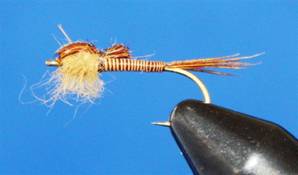
8. Brown/Olive Quill Nymph
- Hook: TMC 101 Size: 12-22
- Thread: Dark Dun 12/0
- Tails: Yellow/Olive dyed Pheasant Tail Fibers
- Abdomen: Stripped Brown Hackle Stem, wrapped. Now, the trick is to brush the thread under the Abdomen with ‘Brush on’ Crazy Glue. This will eliminate the need for cross ribbing and make the imitation much more durable.
- Wingcases: Yellow/Olive dyed Pheasant Tail Fibers, tied in at the eye of the hook, extending forward, and then pulled back over the top of the thorax, to tie off and trimmed. I refer to this method as a Sawyer Style Nymph.
- Thorax: Dubbed, Olive/Brown Rabbit Fur, then pick out the bottom of the thorax to give the illusion of legs.
Notes: I tie several different nymphs, flymphs, emergers and dry flies using hackle stem for the body. This only works if the hackle stems are not brittle and that they wrap and lay on the hook shank properly. The hackle from Conranch is excellent for this endeavor.
Now I could go on and on and on, but believe me when I tell you that you won’t be disappointed with the hackle from Conranch Hackle, nor will you be disappointed with the service or the knowledge of Dennis and Liz Conrad.
I will close by saying that Dennis has a passion for building cane rods and anyone who does that is one of the good guys in my book.
Enjoy & Good Fishin’
From the Desk of the
Wandering Fly Tyer